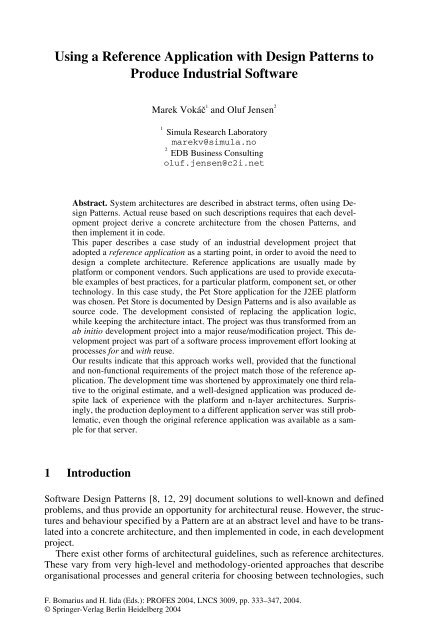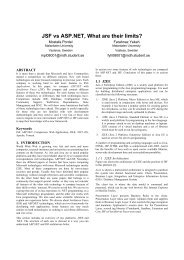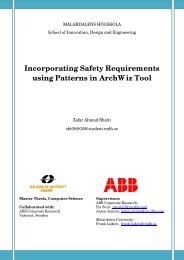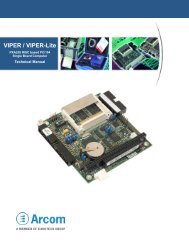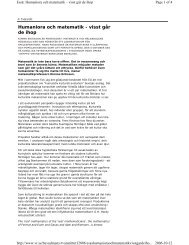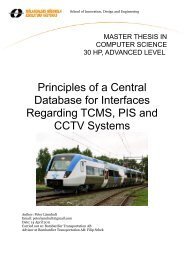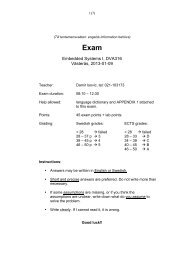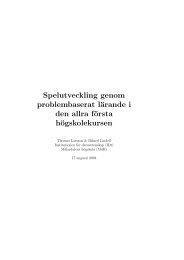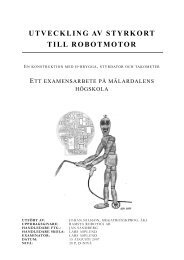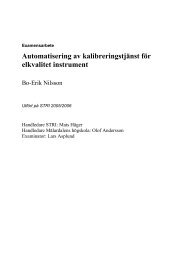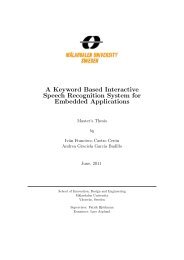LNCS 3009 - Using a Reference Application with Design ... - IDT
LNCS 3009 - Using a Reference Application with Design ... - IDT
LNCS 3009 - Using a Reference Application with Design ... - IDT
You also want an ePaper? Increase the reach of your titles
YUMPU automatically turns print PDFs into web optimized ePapers that Google loves.
<strong>Using</strong> a <strong>Reference</strong> <strong>Application</strong> <strong>with</strong> <strong>Design</strong> Patterns to<br />
Produce Industrial Software<br />
Marek Vokáč 1 and Oluf Jensen 2<br />
1<br />
Simula Research Laboratory<br />
marekv@simula.no<br />
2<br />
EDB Business Consulting<br />
oluf.jensen@c2i.net<br />
Abstract. System architectures are described in abstract terms, often using <strong>Design</strong><br />
Patterns. Actual reuse based on such descriptions requires that each development<br />
project derive a concrete architecture from the chosen Patterns, and<br />
then implement it in code.<br />
This paper describes a case study of an industrial development project that<br />
adopted a reference application as a starting point, in order to avoid the need to<br />
design a complete architecture. <strong>Reference</strong> applications are usually made by<br />
platform or component vendors. Such applications are used to provide executable<br />
examples of best practices, for a particular platform, component set, or other<br />
technology. In this case study, the Pet Store application for the J2EE platform<br />
was chosen. Pet Store is documented by <strong>Design</strong> Patterns and is also available as<br />
source code. The development consisted of replacing the application logic,<br />
while keeping the architecture intact. The project was thus transformed from an<br />
ab initio development project into a major reuse/modification project. This development<br />
project was part of a software process improvement effort looking at<br />
processes for and <strong>with</strong> reuse.<br />
Our results indicate that this approach works well, provided that the functional<br />
and non-functional requirements of the project match those of the reference application.<br />
The development time was shortened by approximately one third relative<br />
to the original estimate, and a well-designed application was produced despite<br />
lack of experience <strong>with</strong> the platform and n-layer architectures. Surprisingly,<br />
the production deployment to a different application server was still problematic,<br />
even though the original reference application was available as a sample<br />
for that server.<br />
1 Introduction<br />
Software <strong>Design</strong> Patterns [8, 12, 29] document solutions to well-known and defined<br />
problems, and thus provide an opportunity for architectural reuse. However, the structures<br />
and behaviour specified by a Pattern are at an abstract level and have to be translated<br />
into a concrete architecture, and then implemented in code, in each development<br />
project.<br />
There exist other forms of architectural guidelines, such as reference architectures.<br />
These vary from very high-level and methodology-oriented approaches that describe<br />
organisational processes and general criteria for choosing between technologies, such<br />
F. Bomarius and H. Iida (Eds.): PROFES 2004, <strong>LNCS</strong> <strong>3009</strong>, pp. 333–347, 2004.<br />
© Springer-Verlag Berlin Heidelberg 2004
334 M. Vokáč and O. Jensen<br />
as [6], to the more concrete, technological recommendations described in [13], where<br />
possible components of a mobile application are described using prose and UML<br />
diagrams. Still, the burden of correctly designing and implementing the concrete architecture<br />
lies <strong>with</strong> the developers of each particular project.<br />
By contrast, small pieces of sample code tend to illustrate a low-level solution to<br />
an isolated problem, and are more useful as examples than for direct reuse. While<br />
they often assume a particular architectural model, they do not explicitly specify or<br />
provide it.<br />
This paper investigates a different approach: development by reuse and adaptation<br />
of a publicly available reference application. The starting point is a complete, working<br />
application that implements acknowledged best practices, <strong>with</strong> a concrete architecture<br />
documented by reference to well-known <strong>Design</strong> Patterns.<br />
In our case study, the development was based on the Pet Store reference application<br />
[32] available for the J2EE platform. The development was performed by replacing<br />
the user interface, functionality and database structure, while leaving the architecture<br />
and application structure intact.<br />
The decision to attempt large-scale reuse was partly motivated by the wish to quickly<br />
create a high quality Web application, in spite of a lack of experience <strong>with</strong> the<br />
J2EE platform and multi-layered architectures. It was also motivated by an ongoing<br />
software process improvement project, in which the company cooperated <strong>with</strong> several<br />
research institutions. This project defined a refinement process investigating a development<br />
process for and <strong>with</strong> reuse.<br />
This paper contains the following sections: Section 2 reviews reuse concepts and<br />
locates the present contribution in context. Section 3 presents the research methods,<br />
and Section 4 the development project that was studied. Results are described in Section<br />
5, and Section 6 concludes and describes possible future work.<br />
2 Background and Concepts<br />
A major challenge in developing a modern multi-layer, web-oriented application is to<br />
design an architecture that supports the required functionality on the specified platform,<br />
and to translate that architecture into running code. In this section, we look at<br />
some popular forms of software reuse, and define the salient concepts used in the<br />
present paper. These concepts form the basis for the present case study and the project<br />
that was investigated.<br />
2.1 Forms of Reuse<br />
The tradition of software reuse dates back to 1968 [21] and earlier. Over time, several<br />
distinct modes of reuse have been described, as by Thomas, Delis et al. [33]. Their<br />
classification divided reuse into three kinds: verbatim reuse, where a component is not<br />
modified; reuse <strong>with</strong> slight modification; and reuse <strong>with</strong> extensive modification. In<br />
addition, we must take into account the kinds of artefact that are being reused.<br />
At the architectural level, the artefacts available for reuse are abstract. <strong>Design</strong> Patterns<br />
[31], books on Best Practices [3, 17, 22], UML models [13] and more general
<strong>Using</strong> a <strong>Reference</strong> <strong>Application</strong> <strong>with</strong> <strong>Design</strong> Patterns to Produce Industrial Software 335<br />
reference architectures [9] must all be translated into concrete architectures suitable to<br />
the project at hand.<br />
At a more concrete level, we find libraries and frameworks such as STRUTS [4].<br />
Frameworks are used by plugging new components into them, to leverage existing<br />
functions, and to a certain extent, they dictate or encourage a particular architectural<br />
direction.<br />
A concept that has recently received some attention is the product family, as described<br />
in [19, 20]. When individual applications cover overlapping sets of requirements,<br />
there is a potential for a product family <strong>with</strong> shared modules. This often results<br />
in frameworks, libraries or other constructs meant to foster reuse between the applications.<br />
In his seminal paper, Brooks [7] argued that the essence of software lies in its<br />
complexity, conformity, changeability and invisibility; most of the improvements in<br />
the field of programming have addressed accidental factors, such as high-level languages<br />
and system response times (and thereby development cycle speeds). In the<br />
same way, plugging components into a framework or reusing sample code snippets<br />
may not solve the difficult problem of designing an architecture that conforms to a<br />
complex combination of functional, non-functional and platform requirements, while<br />
providing reasonable flexibility for future development. The task becomes especially<br />
difficult when time constraints tempt the project developers to formulate simple solutions<br />
to immediate problems.<br />
2.2 <strong>Reference</strong> <strong>Application</strong>s<br />
Our work is based on the concept of a reference application. Such applications are<br />
made available by platform [23, 24, 32] or component [5, 15, 27] vendors for public<br />
use. They share a number of defining features: they are complete, running applications;<br />
full source code can be downloaded and dissected; they implement current best<br />
practices in the area they are meant to illustrate; and they are very well documented.<br />
We are particularly interested in the fact that a reference application is executable,<br />
and provides full source code in addition to architectural descriptions. In doing so, it<br />
bridges the gap between abstract prescriptions for “good” architecture, and the mass<br />
of details that must be considered in any final implementation. This is one of the more<br />
difficult parts of the design process, and a reference application provides a fully implemented<br />
answer–<strong>with</strong>in the requirements set by its authors.<br />
By basing the development on Sun’s Pet Store reference application, the project<br />
became somewhat similar to a product family project. However, the “original” application<br />
was not an in-house product but instead a publicly available reference application.<br />
The development work belongs to the “reuse <strong>with</strong> extensive modification” kind<br />
at the code level, but “reuse <strong>with</strong> slight modification” at the application and architectural<br />
levels.<br />
2.3 Patterns versus Code<br />
The relationship between the abstract and fairly simple description provided by a<br />
<strong>Design</strong> Pattern and the complex structure that may arise from its implementation can<br />
be illustrated by looking at two central patterns in the Pet Store reference application.
336 M. Vokáč and O. Jensen<br />
One of the most central Patterns is the Model-View-Controller [31], which seemingly<br />
consists of three components. However, as implemented in Pet Store, the Model<br />
part consists of Enterprise JavaBean objects that access the database and process data,<br />
the role of Controller is performed by a set of objects that handle incoming requests,<br />
and the View is generated from screen templates combined <strong>with</strong> dynamic data.<br />
In this way, what is conceptually a fairly simple pattern gives rise to a large number<br />
of objects (4+ for Model, 7 for View, 7 for Controller) for a single Use Case. The<br />
architecture provides considerable flexibility for screen and interaction design, and<br />
separates the business and data access logic from the presentation. However, correctly<br />
deriving and implementing such a design ab initio is not trivial.<br />
At the opposite end from the presentation layer, we find the database. This component<br />
is often specified by the customer, because choosing the company DBMS tends<br />
to be a strategic, high-level decision.<br />
There are several versions of the SQL standard, and each vendor has specific additions,<br />
extensions and limitations. It is therefore often necessary to make changes to<br />
applications when switching from one database to another. For instance, the syntax<br />
and rules for OUTER JOIN varies, and choosing the correct cursor type may have<br />
critical impact on performance. If SQL statements are spread throughout the code,<br />
this becomes a more difficult task.<br />
The Data Access Object pattern specifies that one should make an object that encapsulates<br />
access to a particular resource, while hiding the actual implementation of<br />
the storage mechanism. This is a way of partially achieving “persistence transparency”<br />
as defined in [16]. In the general case, this can be a large task, but implementing<br />
access objects for particular classes is more tedious than difficult.<br />
3 Research Methods<br />
Our research design is a single case study <strong>with</strong> one study unit – the development project<br />
[34]. The study was initiated after the development project was mostly completed,<br />
and was therefore conducted retrospectively. The research was performed as<br />
part of the Software Process Improvement through Knowledge and Experience<br />
(SPIKE) project, a research/industry collaboration partly funded by the Norwegian<br />
research Council.<br />
Data was collected from project documents and logs, including the source code and<br />
UML designs. A full-day post-mortem seminar where all the developers participated<br />
was conducted. In addition, individual developers and representatives of the customer<br />
were contacted as needed to collect and verify information.<br />
One of the authors (O. J.) served as development project manager and contributed<br />
first-hand experience.<br />
4 The Studied Development Project<br />
The Norwegian public sector actively attempts to provide 24-hour service for its citizens<br />
by using the Internet. The development of publicly accessible portals makes it<br />
possible for anyone to obtain certain services, which would otherwise only be avail-
<strong>Using</strong> a <strong>Reference</strong> <strong>Application</strong> <strong>with</strong> <strong>Design</strong> Patterns to Produce Industrial Software 337<br />
able during normal working hours, at any time. Examples include Inland Revenue<br />
services (including tax returns), work and employment services, Social Benefit services<br />
and Municipal services.<br />
The purpose of this project was to develop one such service, which makes it possible<br />
for the public to apply for a driver’s license over the Internet, and which implements<br />
a secure and automated application process:<br />
• The information received from the applicant is checked for correctness<br />
• The application is checked against the rules and regulations governing driver’s<br />
license applications.<br />
• Once the application for a driver’s license is accepted, it becomes available to a<br />
public servant employed by the Road Authority, who is then responsible for processing<br />
the application.<br />
• The applicant is automatically given a coded reference number by e-mail. This<br />
makes it possible for her to check the status of her application at any time.<br />
• Once the application has been processed and accepted, the applicant may then use<br />
her reference number to select a date for her driver’s license test.<br />
The inception phase of the project produced a Requirements report containing<br />
specifications on several levels: Background and Purpose of the application; Terminology:<br />
methods and tools; a Business Process Model description; a Use Case Model<br />
description; a High level Business Class skeleton; sketches of User Dialog and Forms<br />
(HTML), and Database Models. This report also ensured that the customer’s basic<br />
requirements were well documented. A short description of two central Use Cases<br />
follows:<br />
USE CASE Registration of license application<br />
The following information is registered:<br />
− Personal information: First name, Last name, social security number, home address<br />
and e-mail address<br />
− Applying for: First time applicant, additional vehicle classes<br />
− What vehicle class<br />
− Health information<br />
The submitted information is checked against public registers and applicable regulations<br />
before it is accepted and stored as a driver’s license application.<br />
USE CASE <strong>Application</strong> status<br />
Any applicant can look up her own application to view its status. The applicant must<br />
use the reference number she received via e-mail when the application was accepted.<br />
4.1 The Pet Store <strong>Reference</strong> <strong>Application</strong><br />
The Pet Store reference application is presented in the book “<strong>Design</strong>ing Enterprise<br />
<strong>Application</strong>s <strong>with</strong> the J2EE Platform” [30]. It conforms to our general definition of<br />
a reference application:
338 M. Vokáč and O. Jensen<br />
“Its goal has been to introduce enterprise developers to the concepts and technology<br />
used in designing applications for the J2EE platform, and to give practical<br />
examples of a typical enterprise application.”<br />
Furthermore, Pet Store is an example of a particular kind of J2EE application:<br />
“The Pet Store application is a typical e-commerce site. The customer selects<br />
items from a catalogue, places them in a shopping cart, and, when ready, purchases<br />
the shopping cart contents. Prior to a purchase, the sample application<br />
displays the order: the selected items, quantity and price for each item, and the<br />
total cost. The customer can revise or update the order. To complete the purchase,<br />
the customer provides a shipping address and a credit card number.”<br />
Pet Store implements a number of hierarchically ordered <strong>Design</strong> Patterns. For instance,<br />
the MVC architectural pattern is implemented using Front Controller and<br />
Composite View, and database access in the Model part is performed by objects conforming<br />
to the Data Access Object pattern. This illustrates which tiers the application<br />
uses, and how to distribute the functionality across the tiers.<br />
Sun’s documentation [32] consists of a high-level architectural overview, followed<br />
by a description of the relevant patterns, <strong>with</strong> references to actual classes and objects<br />
in the Pet Store application.<br />
This provides both a pattern-based description and a working implementation <strong>with</strong><br />
all the details filled in. The application is executable (provided one sets up a database<br />
server), and can be traced/debugged to find the actual order of execution.<br />
The Pet Store reference application has been the subject of some debate in various<br />
Web forums, especially following its use in a benchmark to compare the J2EE and<br />
.NET platforms [2, 10, 35]. It is also referred to in articles such as [28], on analysing<br />
the usage of exceptions in large Java systems, and it is used in university curricula,<br />
e.g. [25]. It is therefore relatively well known among Java/J2EE practitioners.<br />
4.2 Development Methods<br />
In addition to simply developing a new application for a customer, the company also<br />
wished to improve its software development process. To achieve this, the software<br />
process improvement project was established in collaboration <strong>with</strong> research institutions.<br />
One of the goals was to find and establish a refinement process, processes and<br />
methods for and <strong>with</strong> reuse.<br />
The implementation of processes for reuse implies that any future development<br />
project would have access to a “toolbox” of reusable elements, such as model elements,<br />
components or design patterns. The implementation of processes <strong>with</strong> reuse<br />
implies that development projects have knowledge of, and make use of this toolbox of<br />
reusable elements. In an example of successful reuse at Matra Cap Systemes [14], the<br />
process was jump-started by focusing on projects that could produce short-term gains<br />
while at the same time laying the foundation for more long-term reuse. The same<br />
approach was adopted here, by using the Driver’s License project as the starting point<br />
for an improvement process. A crucial process was that of choosing a reuse strategy<br />
for the development project.<br />
Key factors in the evaluation of reuse strategies were that the developers had relatively<br />
little experience <strong>with</strong> the J2EE platform and multi-level architectures. They<br />
therefore wished to find a form of reuse that did not require the design and full implementation<br />
of a complex architecture from abstract descriptions.
<strong>Using</strong> a <strong>Reference</strong> <strong>Application</strong> <strong>with</strong> <strong>Design</strong> Patterns to Produce Industrial Software 339<br />
Given these considerations, and <strong>with</strong> reference to the various forms of reuse outlined<br />
in Section 2, the project chose to look closely at Sun’s Pet Store reference application.<br />
This revealed that Pet Store’s functionality had a sufficient level of similarity<br />
to the new application, as detailed in the next two sections.<br />
4.3 Functional Requirements Matching<br />
The refinement process suggests looking for matching functional requirements. To the<br />
development team, the functional similarities between the two applications were<br />
clear, as illustrated in the following table:<br />
Table 1. Functional mapping between the Pet Store and Driver’s License applications<br />
Driver’s License Pet Store<br />
The applicant selects the service and The customer shops by selecting items<br />
type of license<br />
from a catalogue<br />
The applicant applies for a license The customer places an order<br />
The applicant fills in personal details The customer fills in personal details<br />
Personal details are verified against Credit card data are verified externally;<br />
public registers; rules and regulations order consistency and completeness are<br />
are checked against a rule database verified by ERP or other systems<br />
The applicant receives a confirmation The customer receives a confirmation<br />
e-mail <strong>with</strong> a case ID<br />
e-mail <strong>with</strong> an order ID<br />
Other (legacy) systems may process the An administration manager reviews<br />
same information<br />
stock and enterprise financial data<br />
The database structure used in Pet Store did not match the legacy database that the<br />
Driver’s License application was to use. It was expected that the Data Access Object<br />
pattern used in Pet Store would shield the rest of the application from the necessary<br />
modifications.<br />
4.4 Non-functional Requirements Matching<br />
Simply matching functional requirements is not sufficient to ensure successful reuse;<br />
non-functional requirements also have to be considered. Figure 1 shows a logical<br />
architecture that fits both the Driver’s license and Pet Store applications:<br />
Browser<br />
Internet<br />
Web<br />
Server<br />
Web<br />
Container<br />
EJB<br />
Container<br />
Oracle<br />
DB<br />
Fig. 1. Logical architecture of the Driver’s License application<br />
Legacy<br />
app<br />
(Power-<br />
Builder)
340 M. Vokáč and O. Jensen<br />
The product had to satisfy a number of environmental and other non-functional<br />
constraints. Pet Store matched these requirements quite well, <strong>with</strong> some exceptions:<br />
Table 2. Non-functional mapping between the Pet Store and Driver’s License applications<br />
Driver’s License Pet Store<br />
Platform: J2EE v. 1.2 J2EE v. 1.2<br />
3- or n-layer architecture 3-layer architecture<br />
Browser: IE5 and equivalent Web pages are generated from tagged templates,<br />
adaptable to different browsers<br />
Data storage in legacy database Data is stored through Data Access Objects,<br />
adaptable to requirements; possible mismatch<br />
Deployment platform uncertain Pet Store is a reference/sample application<br />
included by all major platform vendors<br />
Project size: ≤ 10 forms, ≤ 20 Pet Store is a relatively simple e-commerce<br />
database tables<br />
Rigorous validation of personal<br />
details needed<br />
4.5 <strong>Application</strong> Server Compatibility<br />
application of comparable size<br />
Incoming data (orders, addresses) assumed to<br />
be valid; mismatch<br />
The Pet Store application has been used as a benchmark for testing application server<br />
conformance. For instance, IBM includes it on the IBM WebSphere <strong>Application</strong><br />
Server V4.0 for Windows NT product CD. Similarly, Oracle provides a Pet Store<br />
implementation for their Oracle9iAS Containers for J2EE [26].<br />
The Pet Store application is billed as a reference for both architecture and implementation<br />
by Sun, the vendor most involved in defining and implementing the J2EE<br />
platform. It seemed reasonable to have a high degree of confidence in the compatibility<br />
of the application <strong>with</strong> all the major server platforms.<br />
It was therefore expected that basing the Driver’s License application on Pet Store<br />
would make it simple to port it to different application servers. This was an important<br />
requirement, since the customer for the system had not made the final choice of application<br />
server at the time the project began. A server change was consequently almost<br />
unavoidable.<br />
4.6 Other Factors<br />
Basing development on Pet Store was expected to give the development team a number<br />
of advantages not available <strong>with</strong> other forms of reuse:<br />
Development and implementation would be carried out by replacing all modules<br />
<strong>with</strong>in each tier <strong>with</strong> project-specific code. The Pet Store architecture would be retained<br />
while replacing the actual functionality, avoiding the need for an architectural<br />
design, prototyping, etc.<br />
Because the application would be executable from day one, regressions were expected<br />
to be easy to identify. The developers, project management and the customer
<strong>Using</strong> a <strong>Reference</strong> <strong>Application</strong> <strong>with</strong> <strong>Design</strong> Patterns to Produce Industrial Software 341<br />
would be able to see a running version that implemented the full production architecture<br />
at frequent intervals.<br />
Finally, the total time used in development was expected to be less than for a normal<br />
development process, since development effort could focus directly on<br />
implementation, bypassing architecture and design. The project management expected<br />
to be able to show a working subset of the application to the customer after only two<br />
iterations, at least one iteration less than would otherwise have been the case. An<br />
iteration normally lasted about 3 weeks.<br />
5 Results<br />
Our case study found results that can be related to four different areas of the development<br />
project: organization; implementation; data structure and security; and deployment.<br />
5.1 Project Organization<br />
At the outset, the project team decided on a software development process that resembled<br />
the Unified Process approach [18]. The U.P. promotes iterative development,<br />
and describes iterations <strong>with</strong>in the following phases: Inception, Elaboration,<br />
Construction, and Transition.<br />
With a working application as a basis, iterations could be run in parallel in two<br />
phases that are usually performed in sequence: the Elaboration phase and the Construction<br />
phase. The Elaboration phase could focus more on identifying high-risk<br />
functionality and non-functional requirements, while the Construction phase focused<br />
on the implementation of a stable executable subset of the final product. At the same<br />
time, a <strong>Design</strong> and Implementation model was produced through reverse engineering<br />
at regular intervals. Otherwise, design and architectural activities were largely considered<br />
unnecessary, since the development effort was “reuse <strong>with</strong> only slight modifications”<br />
at the architectural level.<br />
On average, six developers were involved. The development team was initially organized<br />
according to the defined tiers: two people were responsible for the client tier,<br />
two were working on the EJB tier, one person was working on the WEB tier, and one<br />
person was responsible for the database tier. Earlier experience suggests that this<br />
approach has a number of benefits [11].<br />
However, as development work progressed, it turned out that it would be better to<br />
reorganize work according to what design patterns a team member was working on.<br />
In other words, when a person was working on the Front controller pattern (which<br />
starts in the WEB tier), then he would also be responsible for the controller-related<br />
objects for that function in the EJB tier.<br />
This provided team members <strong>with</strong> cleaner interfaces between each other’s functionality<br />
and design patterns, and clear functional responsibilities. The project management<br />
also had a better control of responsibility for separate functionality. A consequence<br />
was better management and implementation of change orders from the customer.
342 M. Vokáč and O. Jensen<br />
However, there were exceptions to this rule. The people working on the client tier<br />
were, in the early stages, very occupied <strong>with</strong> the design of the application forms, and<br />
parameterization to the WEB tier.<br />
5.2 Implementation<br />
The implementation discipline had to produce a working subset of the final product at<br />
regular intervals, maintain the implementation model, and solve data validation and<br />
security issues. At the outset, the project had a working Pet Store enterprise application.<br />
This was now to be transformed into a Driver’s License application enterprise<br />
system.<br />
The prime use case was defined as Registration of license application (Section 4).<br />
The first functional subset to be produced had to receive and process a driver’s licence<br />
application, through all tiers, and store it successfully in the database. This<br />
implied connecting all the different tiers so that application form data could be properly<br />
processed and stored in the database.<br />
Connecting a new set of client tier web pages to the WEB tier proved simple. Once<br />
the web pages were designed, it was largely a parameterization task to secure a connection<br />
to the various handlers on the WEB tier. This is largely due to the screen<br />
definitions held in xml files, inherent in the Pet Store design.<br />
Similarly, the connection between the WEB tier and the EJB tier proved to be simple,<br />
as the event handling mechanism is largely independent of the events it handles.<br />
5.3 Database Structure and Data Security<br />
The data validation and security issues clearly belonged to the database tier. Solving<br />
these issues in this tier caused no conflicts <strong>with</strong> the functional responsibilities of the<br />
rest of the development team.<br />
The structure of the legacy database was completely different from that of the Pet<br />
Store database. This required changes in the bean-managed persistent entity beans,<br />
and their Data Access Object pattern. The interaction between the Controller administrating<br />
calls to the database, and the entity beans performing the calls, also had to be<br />
reworked.<br />
The validation and security issue was caused by a fundamental mismatch between<br />
an assumption underlying Pet Store and the Driver’s License application. Since the<br />
Pet Store is a shop, it assumes that its customers will provide valid data and simply<br />
accepts the data proffered. However, in our case there are extensive rules and regulations<br />
to take into account. Also, since the end result–a driver’s license–is a valuable<br />
legal document, there is a danger of malicious misuse and fraud. It is therefore necessary<br />
to validate and protect the data in what was previously a closed, in-house system<br />
at the Road Authority.<br />
The security issue was resolved by storing driver’s license application information<br />
in temporary tables until the system approved the application. Triggers and stored<br />
procedures ensured that accepted and approved application data was moved to the<br />
proper tables. This process was not part of the Java application logic at all. <strong>Application</strong><br />
data that was not accepted was discarded. Both the database structure and security<br />
issues required several iterations before they were satisfactorily closed.
<strong>Using</strong> a <strong>Reference</strong> <strong>Application</strong> <strong>with</strong> <strong>Design</strong> Patterns to Produce Industrial Software 343<br />
In the first iteration, no such temporary tables were implemented. In addition, only<br />
page one of the application form was stored in the database. Then, step by step during<br />
the following iterations, data from all application form pages were stored securely in<br />
the database. This had no negative impact on the progress of the rest of the project.<br />
5.4 Deployment<br />
Deployment on the production platform was the focus of the transition phase. During<br />
the preceding elaboration and construction phases, all implementation and deployment<br />
were performed using the Oracle OC4J application server. This application<br />
server is very easy to use, enabling the development team to produce subsets of the<br />
final product at short intervals.<br />
Six months into the construction phase, the customer decided to implement its new<br />
public portal on the IBM Websphere 4.01 application server. The transition to this<br />
new application server proved to be difficult. Both the original Pet Store application<br />
and the Driver’s License application failed to deploy to this server.<br />
This came as a surprise to the development team. If the Pet Store enterprise application<br />
acts as a reference application, then it should be able to run on all application<br />
servers that are certified to run J2EE. Conclusions derived from researching the issue<br />
can be summarized as follows:<br />
− Different application servers have different deployment descriptor files, and these<br />
are organized differently.<br />
− OC4J had a simpler and less restrictive RMI check, while Websphere required a<br />
strong RMI check.<br />
− The classloaders of Websphere caused problems, and may be related to the strong<br />
RMI check.<br />
− The Websphere single server edition behaved differently than the advanced edition.<br />
− Websphere generally proved very difficult to work <strong>with</strong> [1]. The compile, deploy,<br />
and run cycle was slow and required a lot of machine resources. Debugging was<br />
difficult, and often gave little valuable information.<br />
6 Conclusions and Future Work<br />
Our case study investigated a commercial project to develop a Web-based public<br />
service, for applying for driver’s licenses. Having completed the requirements documentation,<br />
the project had a choice between several possible strategies for the actual<br />
development. One possibility was to design and implement the application from the<br />
ground up, using available tools in the form of <strong>Design</strong> Patterns, documented Best<br />
Practices and sample code.<br />
Alternatively, it could be designed around a commercial or public domain framework<br />
or library. Ultimately, the team chose a different approach, by basing development<br />
on a reference application.
344 M. Vokáč and O. Jensen<br />
The developers had relatively little experience <strong>with</strong> the J2EE platform and multilevel<br />
architectures. They therefore wished to find a form of reuse that did not require<br />
the design and full implementation of a complex architecture from abstract descriptions,<br />
such as <strong>Design</strong> Patterns or architecture guidelines. The Pet Store reference<br />
application had a sufficient level of functional and non-functional similarity to the<br />
new application that it was chosen as the basis for the new application.<br />
The development team, together <strong>with</strong> central members from the participating research<br />
institutions, performed a post mortem analysis on the project experience. The<br />
following sections summarize the results.<br />
6.1 Positive Experiences<br />
Through Pet Store, the project possessed a basic architecture that employed the current<br />
best practices on J2EE design patterns and technology. Since the application was<br />
already implemented, little effort needed to be focused on architectural issues, and<br />
most effort was expended on implementation activities.<br />
The learning curve for the team members was very good. This was definitely a<br />
problem-based learning approach, while at the same time the textbook answer was<br />
readily at hand.<br />
The development tasks were considered professionally challenging, both <strong>with</strong> regard<br />
to functions of the final product, and to the implementation in a new and immature<br />
technology. The team motivation was therefore high, even though this was no<br />
longer a “pure” development project.<br />
Collaboration <strong>with</strong>in the group was very good. Because of the chosen approach,<br />
there was always an executable application, and it was therefore easier to coordinate<br />
the efforts of the team members. The problem of people working for an extended<br />
period on an isolated problem and thereby drifting away from the group was avoided.<br />
The total time and effort spent on the development matched expectations quite<br />
well. There is no doubt that this approach worked well for the application, and resulted<br />
in a combination of flexible architecture and short time to market that would<br />
otherwise have been hard to achieve.<br />
6.2 Negative Experiences<br />
Deployment on a production application server was expected to be easy, since Pet<br />
Store–the reference application used as a basis–is supplied as a sample application by<br />
the platform vendors. However, this turned out not to be the case, and even <strong>with</strong> assistance<br />
from the vendor, it was difficult to deploy both Pet Store and the new application<br />
on the production server.<br />
The database design in Pet Store is stand-alone, and the application architecture<br />
does not contain provisions for interfaces and adaptation to existing database schemas<br />
(as opposed to purely technical adaptation to DBMS servers, which is covered by the<br />
Data Access Object pattern used). The database structure issue was solved by rewriting<br />
most of the data access objects, so here the benefit of using Pet Store as a basis<br />
was small.<br />
The mismatch between the assumption of user trustworthiness between Pet Store<br />
and the Driver’s license application is an example of a non-functional requirement
<strong>Using</strong> a <strong>Reference</strong> <strong>Application</strong> <strong>with</strong> <strong>Design</strong> Patterns to Produce Industrial Software 345<br />
that has architectural implications. When evaluating a development approach, it is<br />
important to check both functional and non-functional requirements closely. Special<br />
attention should be paid to non-functional requirements, even if it can be more difficult<br />
than checking functional requirements.<br />
6.3 Conclusions<br />
Basing new development on the code of an existing, well-documented application can<br />
be a viable method of reuse. Provided that functional and non-functional requirements<br />
match, the actual domain of the reference application and the new application need<br />
not be the same. Database structure and security are two areas where particular care<br />
must be taken, and where the potential for reuse may be limited. The Pet Store application<br />
by Sun is sufficiently well structured and documented to be usable in this role.<br />
6.4 Future Work<br />
In most e-commerce applications, there is a front end that presents what products are<br />
available, and accepts user information. Other tiers are responsible for processing and<br />
storing this information, and producing a response that is then presented to the user by<br />
the front end. Data is stored in a database and passed on to other systems for further<br />
processing.<br />
In the Pet Store reference application, this functionality is described at two different<br />
levels: at an analytical and design level, through a set of design patterns, and at an<br />
implementation level through the implementation of Pet Store.<br />
The software improvement project defined a refinement process that would produce<br />
a toolbox containing an increasing number of refined model elements, frameworks,<br />
components and design patterns.<br />
The elaboration phase of the development processes should also contain a refinement<br />
discipline, a discipline <strong>with</strong> reuse. The heart of this discipline is a search for<br />
similarities at many levels: functional and non-functional requirements, architecture<br />
and code.<br />
Conversely, refinement for reuse should aim at producing artefacts at many levels.<br />
One way would be to attempt to refine a Pet Store type application into a set of design<br />
patterns (a pattern language for e-commerce applications?), and their equivalent components.<br />
Then, when a similar e-commerce application is to be developed, the development<br />
process would mostly be a process of connecting a set of well-defined design patterns<br />
and their components into a working application.<br />
Some of the preconditions needed to succeed using the reference-application approach<br />
were stated in the sections on functional and non-functional requirement<br />
matching (4.3–4.6). Further work is needed to determine a more general specification<br />
of the necessary and sufficient conditions.<br />
Acknowledgments. The authors are most grateful to Prof. Dag Sjøberg, Prof. Ray<br />
Welland and Andrew McDonald for their extensive input and comments. This project<br />
was in part funded by the Norwegian Research Council as part of the SPIKE project.
346 M. Vokáč and O. Jensen<br />
We would also like to mention the entire project development team at EDB Business<br />
Consulting, <strong>with</strong>out whom this project would not have been a success.<br />
<strong>Reference</strong>s<br />
1. Aeinehchi, N., Do NOT use WebSphere unless you are BLUE. 2002.<br />
http://www.theserverside.com/reviews/thread.jsp?thread_id=13639<br />
2. Almaer, D., Making a Real World PetStore, TSS Newsletter #31. 2002, The Server Side.<br />
http://www.theserverside.com/resources/article.jsp?l=PetStore<br />
3. Alur, D., J. Crupi, and D. Malks, Core J2EE Patterns. 2001: Sun Microsystems, Inc. 460.<br />
4. Apache Jakarta Project, STRUTS home page. 2003. http://jakarta.apache.org/struts/<br />
5. ATG, ATG Business Commerce <strong>Reference</strong> <strong>Application</strong> Guide. 2003, ATG.<br />
http://www.atg.com/repositories/ContentCatalogRepository_en/manuals/ATG6.0.0/pdf/A<br />
TG6BusCommRefGuide.pdf<br />
6. Bernus, P. and L. Nemes, A framework to define a generic enterprise reference<br />
architecture and methodology. Computer Integrated Manufacturing Systems, 1996. 9(3):<br />
p. 179-191.<br />
7. Brooks, F.P.J., No silver bullet: Essence and accidents of Software Engineering. IEEE<br />
Computer, 1987.<br />
8. Buschmann, F., et al., Pattern-Oriented Software Architecture. 1996, Chichester: Wiley.<br />
9. Ciancarini, P., et al., Coordinating multiagent applications on the WWW: A reference<br />
architecture. Ieee Transactions on Software Engineering, 1998. 24(5): p. 362-375.<br />
10. Ditzel, C., Charles's Corner: Java Technology Pointers. 2003, Sun.<br />
http://java.sun.com/jugs/pointers.html<br />
11. Frederick, C. Extreme Programming: Growing a Team Horizontally. in XP/Agile<br />
Universe 2003. 2003: Springer-Verlag Heidelberg.<br />
12. Gamma, E., et al., <strong>Design</strong> Patterns: Elements of reusable object-oriented software. 1995:<br />
Addison-Wesley, Reading, MA, 1995.<br />
13. Hallsteinsen, S. and E. Swane, Handling the diversity of networked devices by means of a<br />
product family approach, in Software Product-Family Engineering. 2002. p. 264-281.<br />
14. Henry, E. and B. Faller, Large-scale industrial reuse to reduce cost and cycle time.<br />
Software, IEEE, 1995. 12(5): p. 47-53.<br />
15. Infragistics, Expense <strong>Application</strong> - reference application. 2003, Infragistics.<br />
http://www.infragistics.com/products/thinreference.asp<br />
16. ISO, ISO/IEC 10746: Information technology -- Open Distributed Processing --<br />
<strong>Reference</strong> model. 1998. http://www.iso.org/iso/en/<br />
CombinedQueryResult.CombinedQueryResult?queryString=10746<br />
17. Kassem, N., <strong>Design</strong>ing Enterprise <strong>Application</strong>s <strong>with</strong> the J2EE Platform. 2000: Addison-<br />
Wesley Pub Co. 368.<br />
18. Larman, C., Applying UML and Patterns: An Introduction to Object-Oriented Analysis<br />
and <strong>Design</strong> and the Unified Process. 2nd ed. 2001: Prentice Hall. 656.<br />
19. van der Linden, F., Software product families in Europe: the Esaps & Cafe projects.<br />
IEEE Software, 2002. 19(4): p. 41-49.<br />
20. van der Linden, F. and J.K. Muller. Composing product families from reusable<br />
components. in Systems Engineering of Computer Based Systems, 1995., Proceedings of<br />
the 1995 International Symposium and Workshop on. 1995.<br />
21. McIlroy, D. Mass produced software components. in NATO Conference. 1968.<br />
Garmisch, Germany.<br />
22. Microsoft, <strong>Application</strong> Architecture for .NET: <strong>Design</strong>ing <strong>Application</strong>s & Services. 2003:<br />
Microsoft Press. 200.
<strong>Using</strong> a <strong>Reference</strong> <strong>Application</strong> <strong>with</strong> <strong>Design</strong> Patterns to Produce Industrial Software 347<br />
23. Microsoft, Duwamish 7.0. 2003, Microsoft.<br />
http://msdn.microsoft.com/netframework/downloads/samples/?pull=/library/en-us/dnbda/<br />
html/bdasampduwam7.asp<br />
24. Microsoft, Microsoft .NET Pet Shop 2.0. 2003, Microsoft.<br />
http://msdn.microsoft.com/netframework/downloads/samples/?pull=/library/en-us/dnbda/<br />
html/bdasamppet.asp<br />
25. Ngu, A., CS5369A Enterprise <strong>Application</strong> Integration. 2003, Department of Computer<br />
Science, Southwest Texas State University.<br />
http://www.cs.swt.edu/~hn12/teaching/cs5369/2003Spring/admin/intro.html<br />
26. Oracle, Oracle9iAS Containers for J2EE User's Guide Release 2 (9.0.2). 2003, Oracle<br />
Inc. http://otn.oracle.com/tech/java/oc4j/doc_library/902/A95880_01/html/toc.htm<br />
27. Rational Inc, PearlCircle Online Auction for J2EE. 2003, Rational Inc.<br />
http://www.rational.com/rda/wn_2002.jsp?SMSESSION=NO#pearlcircle<br />
28. Reimer, D. and H. Srinivasan. Analyzing Exception Usage in Large Java <strong>Application</strong>s. in<br />
ECOOP workshop on Exception Handling. 2003. Dramstadt.<br />
29. Rising, L., The Patterns Handbook. 1998: Cambridge University Press.<br />
30. Singh, I., et al., <strong>Design</strong>ing Enterprise <strong>Application</strong>s <strong>with</strong> the J2EE Platform. 2002:<br />
Addison-Wesley. 352.<br />
31. Sun, J2EE Patterns Catalog. 2002, Sun Microsystems, Inc.<br />
http://java.sun.com/blueprints/patterns/j2ee_patterns/index.html<br />
32. Sun, Java Pet Store Demo 1.1.2. 2003, Sun.<br />
http://java.sun.com/blueprints/code/jps11/docs/index.html<br />
33. Thomas, W.T., A. Delis, and V.R. Basili, An analysis of errors in a reuse-oriented<br />
development environment. 1995, University of Maryland, Institute of Advanced<br />
Computer Studies.<br />
34. Yin, R.K., Case Study Research, <strong>Design</strong> and Methods. 3rd ed. 2003, Thousand Oaks,<br />
CA.: Sage Publications.<br />
35. Öberg, R., Review of "The Petstore Revisited: J2EE vs .NET <strong>Application</strong> Server<br />
Performance Benchmark". 2003, Rickard Öberg.<br />
http://www.google.com/search?q=cache:8OPCFEFDFd0J:www.dreambean.com/<br />
petstore.html+petstore+java+experience&hl=en&ie=UTF-8


